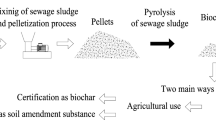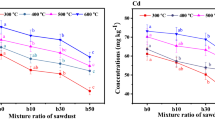Abstract
The aim of this study was to evaluate and compare the properties of sewage sludge pellet (SSP) biochar prepared using two different pyrolysis methods: (i) in a muffle furnace when feedstock was covered by a double layer of aluminium foil and (ii) in a tube furnace without any cover and under N2 atmosphere. The biochar was produced from dried municipal sewage sludge (MSS) pellets by pyrolysis at temperatures of 300, 400, 500 and 600 °C. The feedstock and different biochar properties (such as pH, ash content, elemental composition and leaching behaviour) were investigated. High amounts of heavy metals, especially of Zn (1300 mg/kg) and Cu (326 mg/kg), were determined in the raw material. An increase in pyrolysis temperature led to an increase in heavy metal (Cr, Cu, Mn, Ni, Pb and Zn) concentrations. Nevertheless, the leaching results showed that pyrolysis of sewage sludge at 500–600 °C produced biochar from which only negligible amounts of heavy metals could leach. The study also revealed that the properties of differently produced biochars differed only slightly between the two preparation methods; therefore, both biochar pyrolysis methods could be considered equivalent. In addition, the adsorption of phosphate (PO4-P) was investigated by using SSP biochar (which was crushed to 1–2-mm size) prepared at 600 °C. The maximum obtained adsorption capacity of such biochar was 1.04 mg/g. Produced SSP biochar can be used for the removal of PO4-P from domestic or industrial wastewater or landfill leachate.



Similar content being viewed by others
Data availability
The datasets used and/or analysed during the current study are available from the corresponding author on reasonable request.
References
Shamuyarira K, Gumbo J (2014) Assessment of heavy metals in municipal sewage sludge: a case study of Limpopo Province, South Africa. Int J Environ Res Public Health 11:2569–2579. https://doi.org/10.3390/ijerph110302569
Gorazda K, Tarko B, Wzorek Z et al (2016) Characteristic of wet method of phosphorus recovery from polish sewage sludge ash with nitric acid. Open Chem 14:37–45. https://doi.org/10.1515/chem-2016-0006
Mattenberger H, Fraissler G, Brunner T et al (2008) Sewage sludge ash to phosphorus fertiliser: variables influencing heavy metal removal during thermochemical treatment. Waste Manag 28:2709–2722. https://doi.org/10.1016/j.wasman.2008.01.005
Inc M& E, Tchobanoglous G, Burton FL, et al (2013) Wastewater engineering: treatment and resource recovery. McGraw Hill Education, New York, NY, New York
Park YJ, Moon SO, Heo J (2003) Crystalline phase control of glass ceramics obtained from sewage sludge fly ash. Ceram Int 29:223–227. https://doi.org/10.1016/S0272-8842(02)00109-8
Phoungthong K, Zhang H, Shao L-M, He P-J (2018) Leaching characteristics and phytotoxic effects of sewage sludge biochar. J Mater Cycles Waste Manag 20: https://doi.org/10.1007/s10163-018-0763-0
Száková J, Pulkrabová J, Černý J et al (2019) Selected persistent organic pollutants (POPs) in the rhizosphere of sewage sludge-treated soil: implications for the biodegradability of POPs. Arch Agron Soil Sci 65:994–1009. https://doi.org/10.1080/03650340.2018.1543945
Stasinakis AS, Thomaidis NS, Arvaniti OS et al (2013) Contribution of primary and secondary treatment on the removal of benzothiazoles, benzotriazoles, endocrine disruptors, pharmaceuticals and perfluorinated compounds in a sewage treatment plant. Sci Total Environ 463–464:1067–1075. https://doi.org/10.1016/j.scitotenv.2013.06.087
Liew CS, Yunus NM, Chidi BS et al (2022) A review on recent disposal of hazardous sewage sludge via anaerobic digestion and novel composting. J Hazard Mater 423:126995. https://doi.org/10.1016/j.jhazmat.2021.126995
Liew C-S, Kiatkittipong W, Lim J-W et al (2021) Stabilization of heavy metals loaded sewage sludge: reviewing conventional to state-of-the-art thermal treatments in achieving energy sustainability. Chemosphere 277:130310. https://doi.org/10.1016/j.chemosphere.2021.130310
Meng L, Li W, Zhang S et al (2021) Improving sewage sludge compost process and quality by carbon sources addition. Sci Rep 11:1319. https://doi.org/10.1038/s41598-020-79443-3
Dauknys R, Mažeikienė A, Paliulis D (2020) Effect of ultrasound and high voltage disintegration on sludge digestion process. J Environ Manage 270:110833. https://doi.org/10.1016/j.jenvman.2020.110833
Donatello S, Freeman-Pask A, Tyrer M, Cheeseman CR (2010) Effect of milling and acid washing on the pozzolanic activity of incinerator sewage sludge ash. Cem Concr Compos 32:54–61. https://doi.org/10.1016/j.cemconcomp.2009.09.002
Oladejo J, Shi K, Luo X et al (2018) A review of sludge-to-energy recovery methods. Energies 12:60. https://doi.org/10.3390/en12010060
Cyr M, Coutand M, Clastres P (2007) Technological and environmental behavior of sewage sludge ash (SSA) in cement-based materials. Cem Concr Res 37:1278–1289. https://doi.org/10.1016/j.cemconres.2007.04.003
Devi P, Saroha AK (2014) Risk analysis of pyrolyzed biochar made from paper mill effluent treatment plant sludge for bioavailability and eco-toxicity of heavy metals. Bioresour Technol 162:308–315. https://doi.org/10.1016/j.biortech.2014.03.093
Khanmohammadi Z, Afyuni M, Mosaddeghi MR (2015) Effect of pyrolysis temperature on chemical and physical properties of sewage sludge biochar. Waste Manag Res J a Sustain Circ Econ 33:275–283. https://doi.org/10.1177/0734242X14565210
Figueiredo C, Lopes H, Coser T et al (2018) Influence of pyrolysis temperature on chemical and physical properties of biochar from sewage sludge. Arch Agron Soil Sci 64:881–889. https://doi.org/10.1080/03650340.2017.1407870
Hwang IH, Ouchi Y, Matsuto T (2007) Characteristics of leachate from pyrolysis residue of sewage sludge. Chemosphere 68:1913–1919. https://doi.org/10.1016/j.chemosphere.2007.02.060
Zhang J, Lü F, Zhang H et al (2015) Multiscale visualization of the structural and characteristic changes of sewage sludge biochar oriented towards potential agronomic and environmental implication. Sci Rep 5:9406. https://doi.org/10.1038/srep09406
Chen T, Zhang Y, Wang H et al (2014) Influence of pyrolysis temperature on characteristics and heavy metal adsorptive performance of biochar derived from municipal sewage sludge. Bioresour Technol 164:47–54. https://doi.org/10.1016/j.biortech.2014.04.048
Tang Y, Alam MS, Konhauser KO et al (2019) Influence of pyrolysis temperature on production of digested sludge biochar and its application for ammonium removal from municipal wastewater. J Clean Prod 209:927–936. https://doi.org/10.1016/j.jclepro.2018.10.268
Yuan H, Lu T, Zhao D et al (2013) Influence of temperature on product distribution and biochar properties by municipal sludge pyrolysis. J Mater Cycles Waste Manag 15:357–361. https://doi.org/10.1007/s10163-013-0126-9
Zielińska A, Oleszczuk P, Charmas B et al (2015) Effect of sewage sludge properties on the biochar characteristic. J Anal Appl Pyrolysis 112:201–213. https://doi.org/10.1016/j.jaap.2015.01.025
Fachini J, de Figueiredo CC, Frazão JJ et al (2021) Novel K-enriched organomineral fertilizer from sewage sludge-biochar: chemical, physical and mineralogical characterization. Waste Manag 135:98–108. https://doi.org/10.1016/j.wasman.2021.08.027
Bowden-Green B, Briens L (2016) An investigation of drum granulation of biochar powder. Powder Technol 288:249–254. https://doi.org/10.1016/j.powtec.2015.10.046
Vincevica-Gaile Z, Stankevica K, Irtiseva K et al (2019) Granulation of fly ash and biochar with organic lake sediments – a way to sustainable utilization of waste from bioenergy production. Biomass Bioenerg 125:23–33. https://doi.org/10.1016/j.biombioe.2019.04.004
Chanaka Udayanga WD, Veksha A, Giannis A et al (2018) Fate and distribution of heavy metals during thermal processing of sewage sludge. Fuel 226:721–744. https://doi.org/10.1016/j.fuel.2018.04.045
Pathak A, Dastidar MG, Sreekrishnan TR (2009) Bioleaching of heavy metals from sewage sludge: a review. J Environ Manage 90:2343–2353. https://doi.org/10.1016/j.jenvman.2008.11.005
Mosquera-Losada MR, Muñoz-Ferreiro N, Rigueiro-Rodríguez A (2010) Agronomic characterisation of different types of sewage sludge: policy implications. Waste Manag 30:492–503. https://doi.org/10.1016/j.wasman.2009.09.021
Houshfar E, Løvås T, Skreiberg Ø (2012) Experimental investigation on NOx reduction by primary measures in biomass combustion: straw, peat, sewage sludge, forest residues and wood pellets. Energies 5:270–290. https://doi.org/10.3390/en5020270
Khan S, Wang N, Reid BJ et al (2013) Reduced bioaccumulation of PAHs by Lactuca satuva L. grown in contaminated soil amended with sewage sludge and sewage sludge derived biochar. Environ Pollut 175:64–68. https://doi.org/10.1016/j.envpol.2012.12.014
Kim JA, Vijayaraghavan K, Reddy DHK, Yun Y-S (2018) A phosphorus-enriched biochar fertilizer from bio-fermentation waste: a potential alternative source for phosphorus fertilizers. J Clean Prod 196:163–171. https://doi.org/10.1016/j.jclepro.2018.06.004
Sepúlveda-Cadavid C, Romero JH, Torres M et al (2021) Evaluation of a biochar-based slow-release P fertilizer to improve Spinacia oleracea P use, yield, and nutritional quality. J Soil Sci Plant Nutr 21:2980–2992. https://doi.org/10.1007/s42729-021-00583-0
Rodríguez-Vila A, Selwyn-Smith H, Enunwa L et al (2018) Predicting Cu and Zn sorption capacity of biochar from feedstock C/N ratio and pyrolysis temperature. Environ Sci Pollut Res 25:7730–7739. https://doi.org/10.1007/s11356-017-1047-2
Tan G, Liu Y, Xiao D (2019) Influence of different pyrolysis methods on the sorption property of rice straw biochar. Sep Sci Technol 54:2773–2782. https://doi.org/10.1080/01496395.2018.1553981
Huang H, Tang J, Gao K et al (2017) Characterization of KOH modified biochars from different pyrolysis temperatures and enhanced adsorption of antibiotics. RSC Adv 7:14640–14648. https://doi.org/10.1039/C6RA27881G
Jiang B, Lin Y, Mbog JC (2018) Biochar derived from swine manure digestate and applied on the removals of heavy metals and antibiotics. Bioresour Technol 270:603–611. https://doi.org/10.1016/j.biortech.2018.08.022
Usevičiūtė L, Baltrėnaitė-Gedienė E (2020) Dependence of pyrolysis temperature and lignocellulosic physical-chemical properties of biochar on its wettability. Biomass Convers Biorefinery 1–19. https://doi.org/10.1007/s13399-020-00711-3
EBC (2012) European Biochar Certificate - guidelines for a sustainable production of biochar. Arbaz, Switzerland
Houba VJG, Temminghoff EJM, Gaikhorst GA, van Vark W (2000) Soil analysis procedures using 0.01 M calcium chloride as extraction reagent. Commun Soil Sci Plant Anal 31:1299–1396. https://doi.org/10.1080/00103620009370514
Vasarevičius S, Danila V, Januševičius T (2020) Immobilisation of cadmium, copper, lead, and nickel in soil using nano zerovalent iron particles: ageing effect on heavy metal retention. Water, Air, Soil Pollut 231:496. https://doi.org/10.1007/s11270-020-04864-9
Yin Q, Liu M, Ren H (2019) Biochar produced from the co-pyrolysis of sewage sludge and walnut shell for ammonium and phosphate adsorption from water. J Environ Manage 249:109410. https://doi.org/10.1016/j.jenvman.2019.109410
Hossain MK, Strezov V, Chan KY et al (2011) Influence of pyrolysis temperature on production and nutrient properties of wastewater sludge biochar. J Environ Manage 92:223–228. https://doi.org/10.1016/j.jenvman.2010.09.008
Jin J, Li Y, Zhang J et al (2016) Influence of pyrolysis temperature on properties and environmental safety of heavy metals in biochars derived from municipal sewage sludge. J Hazard Mater 320:417–426. https://doi.org/10.1016/j.jhazmat.2016.08.050
Wang X, Chi Q, Iu X, Wang Y (2019) Influence of pyrolysis temperature on characteristics and environmental risk of heavy metals in pyrolyzed biochar made from hydrothermally treated sewage sludge. Chemosphere 216:698–706. https://doi.org/10.1016/j.chemosphere.2018.10.189
Sun S, Huang X, Lin J et al (2018) Study on the effects of catalysts on the immobilization efficiency and mechanism of heavy metals during the microwave pyrolysis of sludge. Waste Manag 77:131–139. https://doi.org/10.1016/j.wasman.2018.04.046
Lu H, Zhang W, Wang S et al (2013) Characterization of sewage sludge-derived biochars from different feedstocks and pyrolysis temperatures. J Anal Appl Pyrolysis 102:137–143. https://doi.org/10.1016/j.jaap.2013.03.004
Méndez A, Terradillos M, Gascó G (2013) Physicochemical and agronomic properties of biochar from sewage sludge pyrolysed at different temperatures. J Anal Appl Pyrolysis 102:124–130. https://doi.org/10.1016/j.jaap.2013.03.006
Méndez A, Cárdenas-Aguiar E, Paz-Ferreiro J et al (2017) The effect of sewage sludge biochar on peat-based growing media. Biol Agric Hortic 33:40–51. https://doi.org/10.1080/01448765.2016.1185645
Amminudin AL, Ramadhansyah PJ, Doh SI, et al (2020) Effect of dried sewage sludge on compressive strength of concrete. In: IOP Conference Series: Materials Science and Engineering. IOP Publishing, p 012042
Chen X, Li J, Xue Q et al (2020) Sludge biochar as a green additive in cement-based composites: mechanical properties and hydration kinetics. Constr Build Mater 262:120723. https://doi.org/10.1016/j.conbuildmat.2020.120723
Council of the European Communities (1986) Council of the European Communities Council Directive of 12 June 1986 on the protection of the environment, and in particular of the soil, when sewage sludge is used in agriculture (86/278/EEC)
Lu T, Yuan H, Wang Y et al (2016) Characteristic of heavy metals in biochar derived from sewage sludge. J Mater Cycles Waste Manag 18:725–733. https://doi.org/10.1007/s10163-015-0366-y
Yang J, Zhang M, Wang H et al (2021) Efficient recovery of phosphate from aqueous solution using biochar derived from co-pyrolysis of sewage sludge with eggshell. J Environ Chem Eng 9:105354. https://doi.org/10.1016/j.jece.2021.105354
Jiang Y-H, Li A-Y, Deng H et al (2019) Characteristics of nitrogen and phosphorus adsorption by Mg-loaded biochar from different feedstocks. Bioresour Technol 276:183–189. https://doi.org/10.1016/j.biortech.2018.12.079
Vidal B, Hedström A, Herrmann I (2018) Phosphorus reduction in filters for on-site wastewater treatment. J Water Process Eng 22:210–217. https://doi.org/10.1016/j.jwpe.2018.02.005
Mohammadi A (2021) Overview of the benefits and challenges associated with pelletizing biochar. Processes 9:1591. https://doi.org/10.3390/pr9091591
Author information
Authors and Affiliations
Contributions
TJ: conceptualization, methodology, supervision, writing — review and editing; AM: conceptualization, investigation, methodology, writing — original draft; VD: data curation, investigation, writing — original draft; DP: data curation, formal analysis; validation; writing — review and editing.
Corresponding author
Ethics declarations
Ethics approval and consent to participate
Not applicable.
Consent for publication
Not applicable.
Competing interests
The authors declare no competing interests.
Additional information
Publisher’s note
Springer Nature remains neutral with regard to jurisdictional claims in published maps and institutional affiliations.
Rights and permissions
About this article
Cite this article
Januševičius, T., Mažeikienė, A., Danila, V. et al. The characteristics of sewage sludge pellet biochar prepared using two different pyrolysis methods. Biomass Conv. Bioref. 14, 891–900 (2024). https://doi.org/10.1007/s13399-021-02295-y
Received:
Revised:
Accepted:
Published:
Issue Date:
DOI: https://doi.org/10.1007/s13399-021-02295-y




